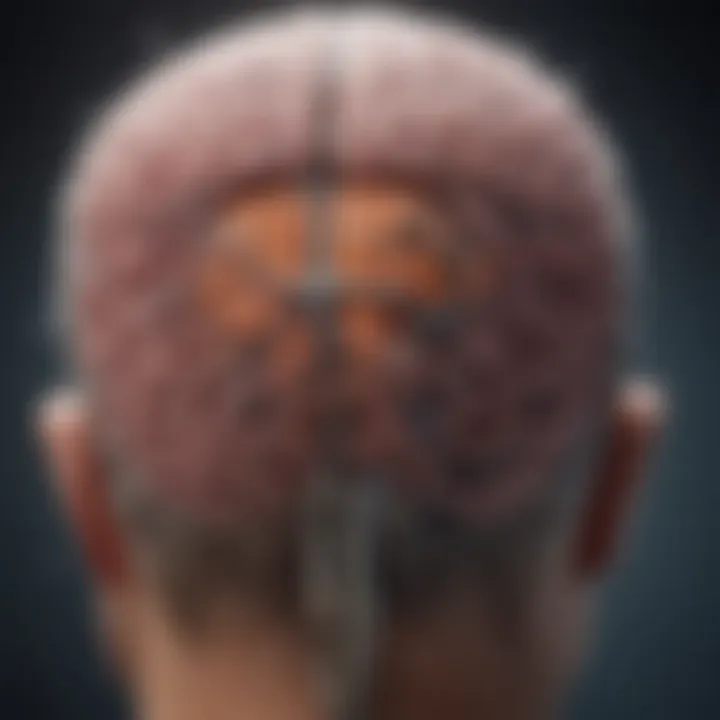Exploring Neuromodulation: Enhancing Brain Function


Article Overview
Purpose of the Article
Neuromodulation represents a significant advancement in understanding how we can enhance brain function. In this article, we will explore various neuromodulation techniques, their therapeutic benefits, and how individuals can access related services in different regions. The intention is to provide a practical guide that informs readers about the mechanisms behind neuromodulation and connects them with available resources and specialists nearby.
Relevance to Multiple Disciplines
The study of neuromodulation crosses several fields, including neuroscience, psychology, and medicine. It encompasses a variety of applications, from improving cognitive function to addressing mental health disorders. Thus, the knowledge gained here is applicable to researchers, educators, clinicians, and students, nurturing a comprehensive understanding of this exciting area.
Research Background
Historical Context
To appreciate the current state of neuromodulation, it is essential to consider its historical evolution. Early concepts date back to studies in neurobiology that highlighted the brain's adaptive capabilities. Over time, technological advancements have enabled more precise interventions that modulate neural activity. Notably, Neuromodulation technology gained popularity in the late 20th century and has since seen explosive growth in both research and clinical application.
Key Concepts and Definitions
In order to grasp the nuances of neuromodulation, some fundamental terms must be defined. Neuromodulation refers to the process by which neurotransmitters and electrical signals impact the activity of neurons, altering how they communicate. This can include techniques like transcranial magnetic stimulation (TMS), deep brain stimulation (DBS), and biofeedback. Each of these methods has distinct mechanisms and applications that offer therapeutic benefits.
Understanding these concepts is crucial for anyone interested in enhancing brain function through neuromodulation techniques.
Understanding Neuromodulation
Neuromodulation is a crucial area of study in neuroscience and medicine. It involves the adjustment of nervous system activity through various techniques and therapies. Understanding neuromodulation offers insight into how we can enhance brain function and potentially improve the quality of life for individuals experiencing neurological and psychological challenges.
By grasping the nuances of neuromodulation, one can appreciate its diverse applications. Neuromodulation techniques can alleviate chronic pain, manage mental health disorders, and aid in the recovery from neurological injuries. These applications reveal the potential of neuromodulation to transform treatment paradigms.
Consideration of neuromodulation is also vital due to the ethical and practical implications it presents. As these techniques become more mainstream, understanding patient consent and long-term effects will become increasingly important. Through this article, we highlight how diverse and multifaceted this field is, paving the way for future enhancements in brain function.
Definition and Mechanisms
Neuromodulation refers to how neurotransmitters influence neural circuits. In simple terms, it can regulate the strength of synaptic transmission. This effect is achieved through various chemical messengers that alter neuronal activity. These mechanisms provide the foundation for therapies used in different clinical settings.
Common molecules for neuromodulation include dopamine, serotonin, and norepinephrine. They affect mood, pain perception, and other cognitive faculties. Understanding these mechanisms helps us to comprehend how different neuromodulation techniques can be tailored to address specific conditions.
Combining stand-alone techniques and drug therapies can enhance efficacy, offering a clearer path toward personalized medicine. Overall, neuromodulation is a promising approach to optimizing brain function and treatment outcomes.
Historical Context
The history of neuromodulation traces back to ancient practices. Early attempts at understanding brain function involved philosophical and rudimentary scientific inquiries. Over the years, advancements in technology led to better insights into the nervous system.
In the 20th century, researchers like Walter Reed and others laid the groundwork for modern neuroscience. Their work enabled the development of neuromodulation techniques, including electrical stimulation and pharmacological interventions. These historical milestones give context to current methods and the rationale behind them.
Through the decades, neuromodulation has evolved from experimental to clinical practice. Today, it stands as a sophisticated and essential aspect of managing various mental and neurological conditions. The journey of this field underscores its importance in pushing the boundaries of what is possible in brain health.
Types of Neuromodulation Techniques
Neuromodulation techniques are essential methods employed to alter the activity of the nervous system. These methods can significantly improve brain function and address various neurological and psychological disorders. Within this realm, different techniques take center stage, each offering unique benefits and considerations. The following are some of the primary techniques utilized in neuromodulation.
Electrical Stimulation
Electrical stimulation involves applying small electrical currents to specific brain regions or nerves to modify their function. This technique can treat conditions such as chronic pain, movement disorders, and even certain mood disorders.
The process typically consists of implantable devices that deliver continuous electrical impulses. One common application is spinal cord stimulation, which can reduce pain signals traveling to the brain.
Benefits of Electrical Stimulation:
- Immediate Relief: Many patients report immediate pain relief after receiving stimulation.
- Adjustable Settings: Practitioners can adjust the levels of stimulation according to individual needs.
Considerations:
- Invasiveness: Involves surgical procedures, which always carry some risks.
- Device Management: Patients need to be aware of device maintenance and battery management.
Pharmacological Approaches
Pharmacological approaches within neuromodulation focus on the use of medications to alter chemical processes in the brain. These can include neuroactive drugs that adjust neurotransmitter levels or receptor activity to enhance mental health or cognitive performance.
Commonly Used Medications:


- Antidepressants: These may modify serotonin levels to help with depression.
- Anxiolytics: Used to counter anxiety by affecting neurotransmitter modulators.
Benefits of Pharmacological Approaches:
- Accessibility: Many of these treatments are readily available through prescriptions.
- Potentially Non-Invasive: Unlike surgical interventions, medication can be an easier route.
Considerations:
- Side Effects: All medications come with potential side effects, and patients must be monitored.
- Dependency Risks: Some drugs may lead to dependency if not managed properly.
Transcranial Magnetic Stimulation
Transcranial Magnetic Stimulation, often called TMS, is a non-invasive method that uses magnetic fields to stimulate nerve cells in the brain. TMS is primarily used for treatment-resistant depression but is being explored for other conditions, such as anxiety and PTSD.
Mechanism of Action:
- TMS involves placing a magnetic coil against the scalp and delivering short magnetic pulses.
Benefits of TMS:
- Non-Invasive: TMS does not require surgery, making it a safer option.
- Minimal Side Effects: Patients generally experience few side effects compared to medications.
Considerations:
- Treatment Duration: Each session usually lasts around 30-40 minutes, requiring multiple sessions.
- Variable Responses: Not all patients respond to TMS, making individual assessment essential.
Deep Brain Stimulation
Deep Brain Stimulation, or DBS, uses implanted electrodes to deliver electrical impulses to specific brain areas. This technique is often employed for patients with Parkinson's disease, essential tremor, and other movement disorders.
How It Works:
- A device generates electrical signals that modulate abnormal brain activity, helping to restore motor function.
Benefits of Deep Brain Stimulation:
- Sustained Relief: Many patients experience long-term relief of symptoms.
- Programmable Stimulation: The adjustment of stimulation parameters is possible based on symptom reports.
Considerations:
- Surgical Risks: As with all invasive procedures, there are risks involved in implantation.
- Device Maintenance: Regular follow-ups and potential adjustments are required to optimize treatment.
Each neuromodulation technique offers distinct mechanisms and benefits. Understanding these variations allows for better decision-making when exploring treatment options.
Each neuromodulation technique offers distinct mechanisms and benefits. Understanding these variations allows for better decision-making when exploring treatment options.
Applications of Neuromodulation
The applications of neuromodulation are vast and critical for enhancing brain function. Neuromodulation techniques have shown promise in treating various medical conditions, impacting how individuals experience pain, cope with neurological disorders, and maintain mental health. This section elaborates on the significance of these applications by exploring chronic pain management, neurological disorders, and mental health treatment.
Chronic Pain Management
Chronic pain affects millions of people and often leads to a diminished quality of life. Neuromodulation provides innovative approaches aimed, at altering the way the brain processes pain signals. Techniques such as electrical stimulation and pharmacological methods can effectively reduce the perception of pain.
By targeting specific nerve pathways, neuromodulation minimizes discomfort without the side effects often associated with traditional medication. For many, this improves daily functioning and reduces reliance on opioids and other painkillers, which can lead to addiction.
Neuromodulation offers a non-invasive or less invasive alternative for pain management, helping patients regain control over their bodies.
Neuromodulation offers a non-invasive or less invasive alternative for pain management, helping patients regain control over their bodies.
Neurological Disorders
Neurological disorders, including epilepsy, Parkinson’s disease, and multiple sclerosis, present unique challenges for patients. Neuromodulation techniques are gaining traction as therapeutic options for these conditions. For instance, deep brain stimulation has been successfully used to reduce symptoms in Parkinson's patients.
Apart from deep brain stimulation, transcranial magnetic stimulation and other neuromodulatory methods have demonstrated potential in managing epilepsy. These methods modify neuronal activity with the goal of enhancing overall brain function. The ability to manipulate brain activity opens new pathways for treatment, offering hope to those who have exhausted traditional therapies.
Mental Health Treatment
Mental health disorders such as depression and anxiety can be debilitating. Neuromodulation has emerged as a significant area of interest for improving mental health outcomes. Techniques like transcranial magnetic stimulation have been studied extensively and show effectiveness in treating resistant cases of depression.
The appeal of neuromodulation in mental health arises from its ability to target the brain's chemistry to promote better emotional regulation. Addressing neural pathways instead of solely using medication represents a paradigm shift in treatment options.


Through the application of these techniques, there is significant potential for research and development focused on mental health treatment.
In summary, the applications of neuromodulation serve crucial roles across various fields, impacting areas significantly related to chronic pain, neurological disorders, and mental health. As these techniques continue to evolve, they might offer improved solutions for managing complex conditions, further enhancing brain function and overall quality of life.
Finding Neuromodulation Services Near You
Finding appropriate neuromodulation services in your region is essential for individuals seeking alternatives to conventional treatments for various conditions. This topic plays a critical role in ensuring that patients have accessibility to expertise in this evolving field. Neuromodulation techniques can significantly aid in addressing chronic pain, neurological disorders, and mental health issues. Therefore, knowing where and how to access these specialized services can greatly enhance outcomes and improve the quality of life for many individuals.
Researching Local Specialists
To effectively research local specialists in neuromodulation, one must begin by identifying reputable facilities and practitioners. This process requires a combination of online searches, referrals, and patient reviews. Many aspects need to be considered during research:
- Check Professional Associations: Organizations like the American Society of Neurorehabilitation often maintain lists of certified specialists.
- Utilize Search Engines: Search queries like "neuromodulation specialists near me" can direct you to local providers with websites detailing their services.
- Consult Medical Forums: Websites like Reddit can provide community insights into patient experiences with local neurologists or pain specialists.
Investigating these aspects will help you form a clear picture of what is available in your local area. Moreover, various cities may have neuromodulation centers that focus specifically on certain techniques, such as electrical stimulation or transcranial magnetic stimulation.
Evaluating Professional Credentials
Once you have a list of potential specialists, evaluating their credentials becomes essential. This ensures that you are seeking treatment from qualified professionals. Focus on the following factors:
- Education and Training: Identify where the specialist completed their medical education and whether they have specialized training in neuromodulation techniques.
- Board Certification: Confirm that the specialist is board certified in their area of expertise, such as neurology or psychiatry. This certification indicates a recognized level of training and competence.
- Professional Experience: Check how long they have been providing neuromodulation services. Experience often correlates with better treatment outcomes.
Thoroughly assessing credentials will lessen the risk of receiving subpar care and guide you toward professionals capable of delivering effective neuromodulation interventions.
Online Resources and Platforms
Several online resources are available to assist in locating neuromodulation services. Utilizing these platforms can streamline the search process. Consider the following:
- Healthgrades.com: This website allows you to search for local healthcare providers while viewing their profiles, patient ratings, and practice locations.
- Zocdoc.com: Zocdoc helps patients book appointments with local specialists, and it often includes reviews from past patients.
- Social Media Groups: Platforms like Facebook have numerous groups dedicated to specific health conditions where members share their experiences and recommendations for local specialists.
These resources not only provide direct access to service providers but also offer invaluable insights into patient satisfaction and the quality of care available in your community.
Recent Advances in Neuromodulation
Neuromodulation is an evolving field that has seen remarkable advancements in recent years. This section examines those advances, focusing on both the innovative techniques that have emerged and the ongoing clinical trials paving the way for future treatments. Understanding these developments is essential for anyone interested in enhancing brain function through neuromodulation.
Innovative Techniques
Recent years have introduced several innovative techniques in the realm of neuromodulation. These techniques not only enhance existing methods but also open doors for new applications. Here are some key innovations:
- Waveform tailoring: Customizing the waveform of electrical stimulation has shown promise in achieving more precise outcomes, adjusting the stimulation to fit individual patient needs.
- Closed-loop systems: These systems continually monitor brain activity and adjust stimulation accordingly. This real-time feedback ensures optimal treatment, minimizing side effects and maximizing benefits.
- Bioelectronic medicine: This area focuses on creating devices that can modulate nerve activity through biofeedback. It has the potential to treat various conditions without traditional medication.
- Ultrasound neuromodulation: Using focused ultrasound to alter brain activity is a less invasive method. It allows for deep brain stimulation without the need for electrodes.
The emergence of these techniques demonstrates a shift toward more personalized neuromodulation therapies. They also suggest an exciting future in which brain function can be tailored to fit individual needs.
Clinical Trials and Research
Clinical trials play a crucial role in validating new neuromodulation techniques. These studies not only assess efficacy but also contribute to understanding long-term effects and safety profiles.
Recent clinical trials have tested various innovative methods. For instance, trials involving transcranial magnetic stimulation are exploring its application in treating depression, demonstrating promising outcomes. Other trials are examining the effectiveness of different neuromodulation protocols for chronic pain management.
"Clinical trials are essential to ensure that new technologies are safe and effective for use in the general population."
"Clinical trials are essential to ensure that new technologies are safe and effective for use in the general population."
Researchers are also observing patient responses, which can vary significantly. This variability impacts how techniques are developed and tailored.
In addition to traditional methods, emerging technologies are being evaluated for their potential applications in neuromodulation. Studies on devices like implanted stimulators provide insights into long-term usability and benefit. Researchers are focused on answering critical questions:
- How effective are these new techniques compared to established methods?
- What long-term impacts do they have on brain function?
- How can the outcomes improve quality of life for patients?
These inquiries drive the continued evolution of neuromodulation.
Understanding and keeping abreast of recent advances in neuromodulation can guide patients, practitioners, and researchers in making informed choices about treatment options. As this field continues to grow, it holds the promise of enhancing brain function through innovative methods and robust clinical evidence.
Ethical Considerations
In the realm of neuromodulation, ethical considerations play a crucial role. As this field continues to evolve, the implications of its technologies raise questions about responsibility, safety, and treatment efficacy. Addressing these ethical issues contributes to fostering trust between patients and healthcare providers, ensuring that all parties are informed and involved in the decision-making process.
Patient Consent


Patient consent is foundational in any medical treatment, including neuromodulation techniques. Before undergoing any procedure, patients must thoroughly understand the nature, potential benefits, and risks associated with the treatment. This involves clear communication between clinicians and patients. Failure to obtain informed consent can lead to legal repercussions and significant ethical dilemmas.
- Informed Decision-Making: Patients should be provided with comprehensive information that allows them to make educated choices about their treatment options. This encompasses details about the procedure, possible outcomes, and alternatives.
- Ongoing Consent: Consent is not a one-time event. Patients should have the right to review and withdraw their consent at any stage of treatment, based on any new findings or changes in their condition.
Long-term Effects
The long-term effects of neuromodulation treatments warrant careful scrutiny. While many techniques show immediate benefits, their lasting impacts are often less understood.
- Monitoring Outcomes: Patients and healthcare providers must track the effects of treatment over time. This information is valuable for understanding how these interventions influence brain function and overall health.
- Potential Risks: While a technique may be effective initially, unforeseen long-term consequences may arise. These could include psychological impacts or changes in neurological status that need to be assessed continuously.
In summary, the ethical considerations in neuromodulation not only shape clinical practices but also influence patient experiences. Addressing patient consent and long-term effects allows for a more ethical approach to treatment.
In summary, the ethical considerations in neuromodulation not only shape clinical practices but also influence patient experiences. Addressing patient consent and long-term effects allows for a more ethical approach to treatment.
The implications of these ethical discussions extend beyond individual practices. They influence guidelines and frameworks that govern the future of neuromodulation, ultimately aiming to enhance patient safety and treatment efficacy.
Cost and Accessibility Issues
The financial and logistical barriers pertaining to neuromodulation services are critical to understanding and embracing this field. Cost and accessibility influence whether individuals can engage with these advanced therapies. They can often present challenges that deter potential patients from exploring effective treatments. Therefore, discussing these issues is vital in addressing the broader picture of enhancing brain function through neuromodulation.
Insurance Coverage
Insurance coverage is a pivotal element in determining access to neuromodulation treatments. Various factors influence whether a particular service is covered. These often include the patient's diagnosis, the specific procedures, and the insurance provider’s policies. Some techniques, such as Deep Brain Stimulation, may receive coverage due to strong clinical backing. However, newer techniques and those still emerging often lack comprehensive insurance engagement.
It is also important for patients to understand their specific plans. This can involve researching if referral requirements must be met, or even if pre-authorization is necessary. Engaging with local neurologists or neuromodulation specialists can help clarify such nuances. Patients should not hesitate to approach their insurance representatives to determine eligibility, coverage limits, or potential out-of-pocket expenses related to these therapies.
Out-of-Pocket Expenses
Even when insurance covers some treatments, out-of-pocket expenses may still pose a significant burden. These costs can include co-pays, deductible amounts, and non-covered service fees. The financial implications can be substantial, especially for procedures that demand multiple sessions, like Transcranial Magnetic Stimulation.
Aside from treatment sessions, indirect costs can emerge. For instance, travel expenses to reach specialized centers can add to the financial load. Therefore, understanding the complete cost structure becomes crucial for individuals seeking these services.
Patients should also consider the availability of financial assistance programs. Some clinics may have payment plans or offer sliding scale fees based on income. It is always prudent to inquire about these options when pursuing specialized care.
Cost and accessibility should not limit the potential benefits of neuromodulation in enhancing brain function.
Cost and accessibility should not limit the potential benefits of neuromodulation in enhancing brain function.
Future of Neuromodulation
The future of neuromodulation holds great promise. As technology advances, the potential for enhancing brain function increases significantly. This section discusses emerging technologies and predicted trends in this evolving field. Understanding these aspects is crucial for researchers, educators, and healthcare professionals investing time in neuromodulation.
Emerging Technologies
Emerging technologies are changing the landscape of neuromodulation. These innovations can provide more precise targeting and greater efficacy in treatment.
- Closed-loop systems: These systems monitor neural activity and adjust stimulation in real-time. This precision might lead to improved outcomes in chronic pain and mental health treatments.
- Wearable devices: Innovations like portable neurostimulation devices can provide neuromodulation therapies outside clinical settings. This accessibility shifts how patients receive interventions, making treatments more convenient and personalized.
- Optogenetics: This technique involves using light to control neurons genetically modified to respond to specific wavelengths. Its application can vastly improve understanding and treatment of various neurological disorders.
- Brain-computer interfaces: Integration of neuromodulation with brain-computer interfaces can allow for new interaction methods between brain activity and external devices. This development may revolutionize rehabilitation strategies for individuals with motor impairments.
Predicted Trends
Several trends are anticipated as neuromodulation continues to evolve:
- Increased personalization: Treatment plans will become more individualized. Advances in neuroimaging and genetic profiling can optimize therapies based on a patient’s unique brain architecture.
- Cross-disciplinary collaboration: As the field matures, collaboration among neuroscientists, computer scientists, and engineers is expected to accelerate innovative solutions. This interdisciplinary approach can enhance the development of novel techniques and applications.
- Broader acceptance and integration: As more evidence-based studies highlight the effectiveness of neuromodulation, greater acceptance in clinical practices will likely follow. Health systems may begin to incorporate these techniques into standard care protocols.
- Focus on ethical guidelines: As the use of neuromodulation expands, establishing comprehensive ethical guidelines will be critical. This focus will ensure that patients receive safe and effective treatments while navigating potential risks.
The future of neuromodulation is not only about enhancing brain function but also about ensuring patients engage fully in their treatment journey.
The future of neuromodulation is not only about enhancing brain function but also about ensuring patients engage fully in their treatment journey.
By examining these elements, professionals in the field can better prepare for the changing landscape of neuromodulation, reinforcing its significance for improving patient outcomes.
The End
In the journey through the vast landscape of neuromodulation, it is clear that this field holds significant promise for enhancing brain function. As we have discussed, neuromodulation encompasses a wide variety of techniques and applications that can address numerous neurological and psychological issues. The potential benefits range from improved management of chronic pain to the treatment of mental health disorders, highlighting the value of these interventions in modern medicine.
Every section of this article underscored the interdisciplinary nature of neuromodulation. Its relevance extends beyond medical practitioners; it incorporates technology, ethics, and patient-centric approaches. Such diversity indicates that ongoing exploration is crucial. Moreover, understanding the intricacies of treatment options, as outlined in our discussions on ethical considerations, cost factors, and local accessibility, allows individuals to make informed decisions about their health.
Recognizing the essential components of neuromodulation facilitates a more profound conversation about its future. Technological advances continue to emerge, enabling the refinement of existing techniques and the development of novel therapies. This evolving nature calls for further inquiry into the efficacy and safety of these methods. As knowledge expands, so too does the potential for individualized care that meets specific patient needs.
In summary, the intersection of neuroscience, technology, and ethics within neuromodulation presents numerous opportunities and challenges. It is imperative for students, researchers, and professionals to combine their expertise to further expand this field. As integration of distinct knowledge areas occurs, we approach a future where neuromodulation may transform how we enhance brain function and improve overall health outcomes.
Summary of Key Points
- Neuromodulation offers various techniques to manage neurological and psychological conditions effectively.
- Ethical considerations and patient consent are critical to its applications.
- The journey of neuromodulation is characterized by ongoing advances and emerging technologies.
- Accessibility and costs of these treatments vary, influencing patient choices.
- A collaborative approach among experts is vital for future advancements.
Call for Further Research
The conclusions drawn from this article illuminate significant gaps in understanding and application within neuromodulation. As the field expands, the importance of clinical trials and innovative studies cannot be overstated. Researchers should focus on the long-term effects of neuromodulation treatments, investigating how they can be optimized for different patients.
Future studies must address the psychological impacts of neuromodulation therapy. Understanding how these interventions affect mental health will aid in fine-tuning techniques and improving outcomes.
Furthermore, it is essential to explore the socioeconomic factors that play a role in access to treatment. Research efforts should aim to create inclusive frameworks that promote equitable distribution of neuromodulation services across various demography. As this field continues to grow, the holistic exploration of its potential will shape the future of brain health and functional enhancement.



